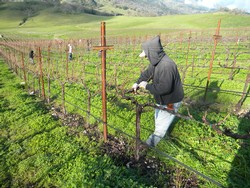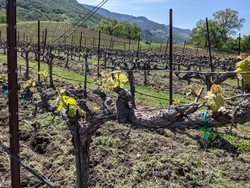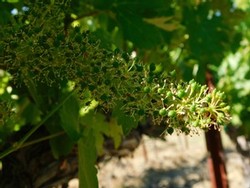Field Craft: Rangeland's Annual Cycle
At Rangeland, we often say that our wines are "field crafted." Although indoors winemaking is important, our wine really is grounded in the vineyard, where we grow our delicious grapes. The diverse soils, warm climate, high elevation, southwest facing aspect and coastward location are all particularly special at our Adelaida Springs Ranch estate vineyard, but the human component is just as important. There are 7 critical stages in the yearly life cycle of our vineyard that require management: pruning, bud break, shoot thinning, bloom, canopy management, veraison and harvest.
Pruning: While They are Sleeping...

Bud break: Rebirth
 We leave about 12 spur positions on each vine and each spur has two or three buds. These buds, formed the previous year, will be the start of this year's crop. They open up and sprout leaves in the first few weeks of spring. This is what we call "bud break." The vines are coming out of a long winter's nap and starting the yearly cycle. Each bud will grow a 3-4 foot, hopefully fruit-bearing cane, in the coming months.
We leave about 12 spur positions on each vine and each spur has two or three buds. These buds, formed the previous year, will be the start of this year's crop. They open up and sprout leaves in the first few weeks of spring. This is what we call "bud break." The vines are coming out of a long winter's nap and starting the yearly cycle. Each bud will grow a 3-4 foot, hopefully fruit-bearing cane, in the coming months.
Shoot Thinning: Taming the Beast
Grapevines are prolific. Despite careful pruning, a healthy vine wants to push extra shoots out, to grow more grapes and seeds for birds (and other critters) to eat, spread and reproduce. So each May, "we" (our labor crew/small army) thin shoots by gently breaking off all of those excess shoots on every plant by hand, allowing the vine to focus its energy on the choice remaining growth. Fine wine grapes need a rough balance between leaves (that act like ripening solar panels) and fruit.
Bloom and Set: Heaven Scent

Canopy Management: Training the Ballerina
Once the canes are fully grown by about the 4th of July, we have to manage them. First, we need to be able to get the tractor down each row, so we lift the shoots with trellis wires. And secondly, we want the grapes to get enough sunlight to develop color and tannins, but we don't want sunburn or shrivel. We flop and fluff the canopy on the sunny morning side to provide some speckled shade. On the shadier afternoon side, we pin the shoots all the way up with wires to get better sun exposure. Our vines end up looking like a ballerina with one arm stretched gracefully to the side. It is not a perfect science, but we strive for fruit intensity and complexity through sun exposure.
Veraison: The Blushing Change
.jpg) Red wine veraison is when the grapes darken and soften. The fruit’s acidity starts to decline and harvest is only 4-6 weeks away. This is a major change, much like puberty for an adolescent, and this is when character and flavor starts to develop. After 2-3 weeks, we do what's called a "green drop", when anything that hasn't turned color yet, is dropped on the ground. This helps the vineyard ripen uniformly. It allows the vine to concentrate its ripening power on the remaining fruit.
Red wine veraison is when the grapes darken and soften. The fruit’s acidity starts to decline and harvest is only 4-6 weeks away. This is a major change, much like puberty for an adolescent, and this is when character and flavor starts to develop. After 2-3 weeks, we do what's called a "green drop", when anything that hasn't turned color yet, is dropped on the ground. This helps the vineyard ripen uniformly. It allows the vine to concentrate its ripening power on the remaining fruit.
Harvest: Off to College
Harvest is the time when the parent vine ships their little grape children off to college so they can learn what they were meant to become! We start measuring grape sugar content and acidity in August, but ultimately I decide when to pick based on fruit flavor. This usually occurs in September and through the middle of October. We hand harvest all of our grapes, and I’m on almost every pick. While the grapes are being picked into the bins, I am standing on the trailer pulling out leaves and under-ripe fruit, while tasting the grapes to see what I want to do with them once they get to the winery. For instance, if there is a lot of tannin in the skins, I might decide to do gentle pump-over during fermentation instead of a more extractive punch down.
Art and Science
This is, of course just a glimpse at the process. Growing good grapes and making fine wine involves a lot technical knowledge and measurement. But ultimately the process is so complex—Laird calls it kaleidoscopic—that the key decisions are artistic. That suits me very well.
Comments
Commenting has been turned off.Keep up to date on the latest wine releases, events, and promotions and get 10% off your next order.